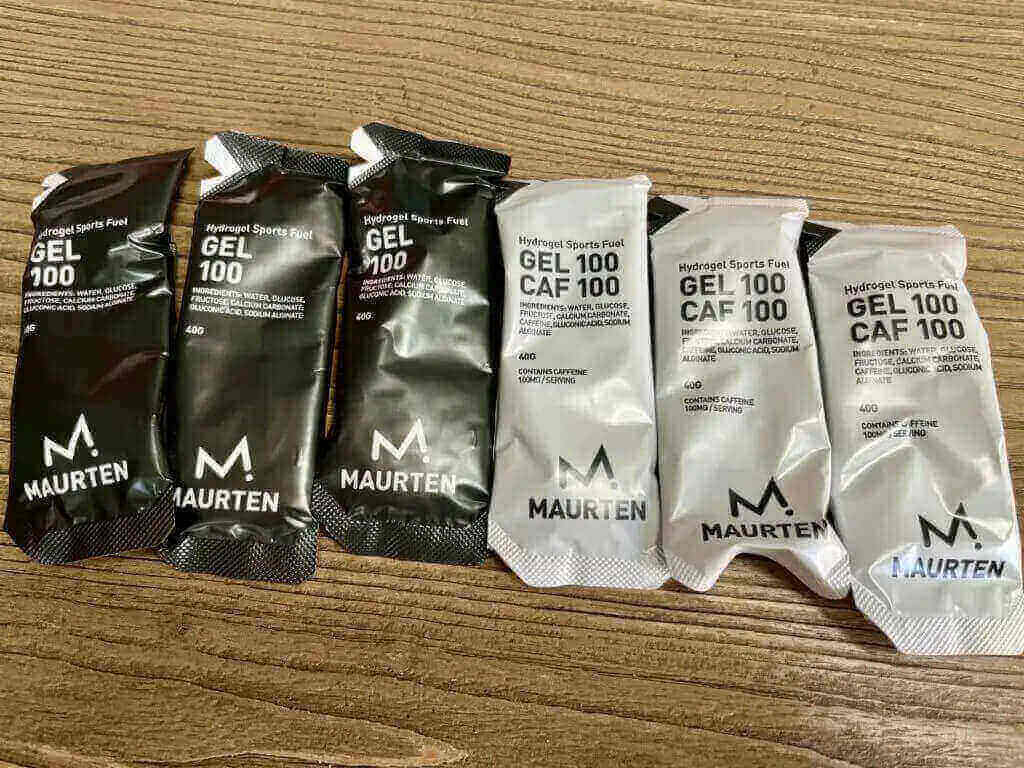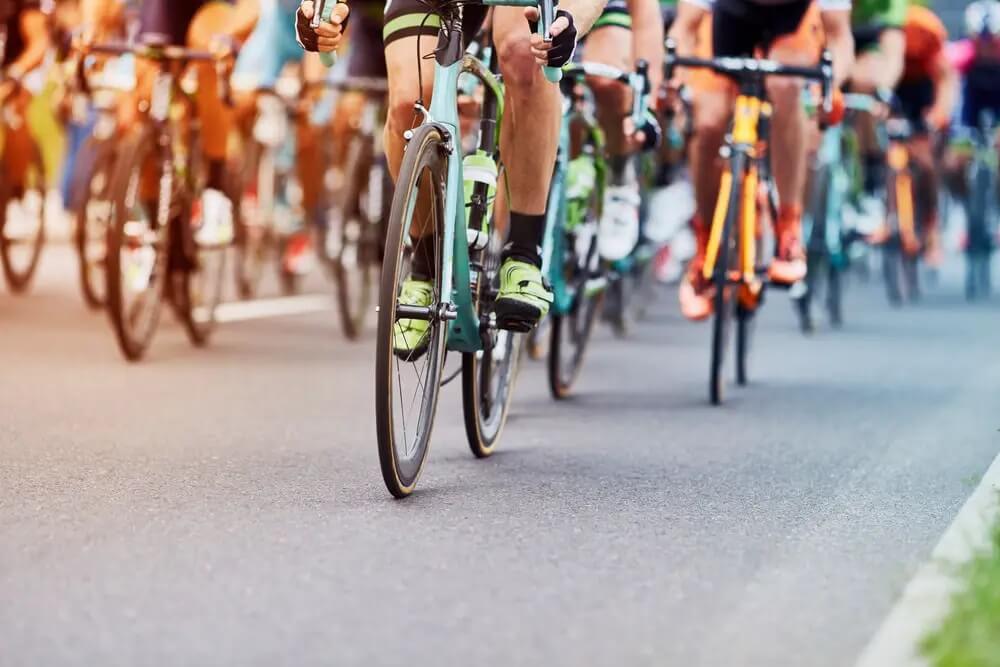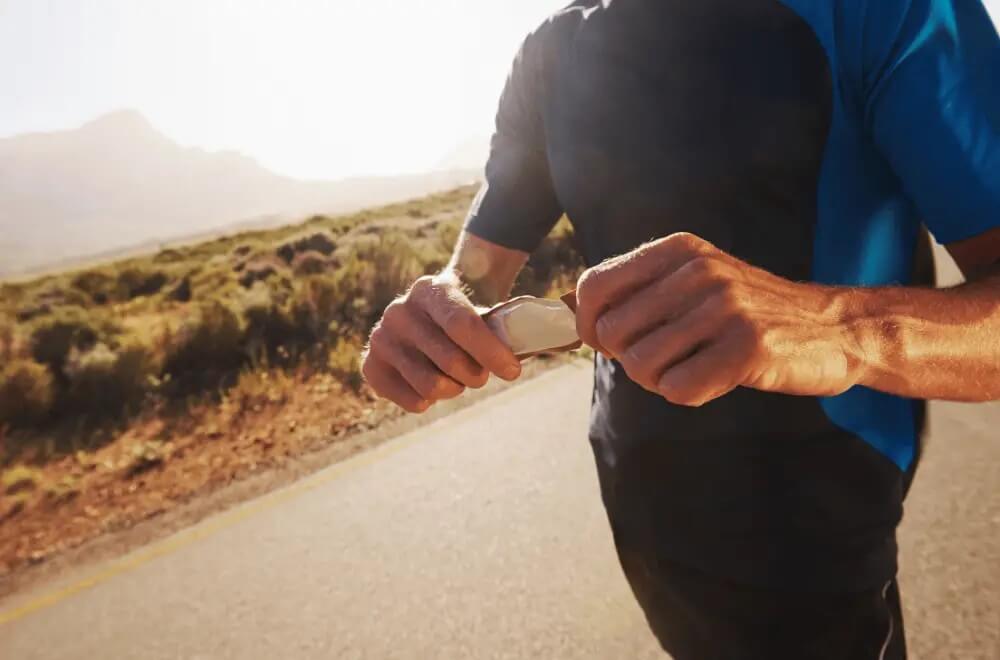Are you wondering when to take energy gels during a triathlon fueling? In this article, our triathlete investigates.
Participating in a triathlon requires enduring stamina and sufficient fueling strategies to energize your body throughout the race. One essential element in a triathlete’s fueling plan is using energy gels, which provide a quick and efficient way to replenish carbohydrates and maintain optimal performance levels.
Knowing when to take energy gels during a triathlon is crucial as it can greatly impact your overall performance. Start consuming energy gels early in the race, when your body isn’t under extreme duress, so it can better process the sugars and provide energy more quickly.
For an effective fueling strategy, take 25-30g gels every 25-30 minutes during exercise, along with up to 200-300ml of water, unless you’re using isotonic gels.
Maurten gels are particularly popular and Eliud Kipchoge regularly uses them for his racing strategy. I recently completed a 70.3 Ironman event and these were the gels of choice by most competitors too. Learn more about what to expect on your first 70.3.
During my last triathlon, I carried six energy gels with me and stuck them in my bike’s Bento box. I also put one or two in my running shorts. The event took me over six hours, and I consumed one of these gels approximately every half hour, except for the swim, I brought a few extra just in case!
Contents
Understanding Energy Gels

Energy gels are a popular and convenient source of carbohydrates, electrolytes, and in some cases, caffeine. They provide a quick boost of energy to triathletes.
Components of Energy Gels
Energy gels contain a mix of the following components:
- Carbohydrates – They serve as the main energy source, typically in the form of maltodextrin or glucose. This energy is quickly absorbed and used by the body to fuel muscles during exercise
- Electrolytes – These are essential minerals such as sodium, potassium, and magnesium, which support hydration and muscle function during exercise.
- Caffeine (optional) – Some gels contain caffeine for an extra energy kick and enhanced mental focus. It is important to consider the individual’s tolerance for caffeine and the timing of consumption during the race.
Benefits for Triathletes
Energy gels offer several benefits during triathlon races:
- Quick energy boost – The easily digestible carbohydrates found in energy gels provide a rapid source of energy, helping to maintain consistent energy levels throughout the race.
- Convenience – Gels are small, lightweight, and easy to carry during the race. They can be quickly consumed with minimal disruption to your race performance.
- Electrolyte replenishment – Electrolytes in the gels help to maintain hydration and ensure proper muscle function, preventing cramps and reducing the risk of dehydration (Marathon Handbook).
When to Take Energy Gels During a Triathlon
Energy gels can provide a quick energy boost to maintain endurance during a triathlon. Knowing when to take them is critical for maximizing their benefits. You might find our explainer on when to take energy gels during a marathon helpful.
The Swim Leg
It’s too hard and messy to attempt to consume a gel while swimming. Instead, consider fueling with a gel 5-30 minutes before the race starts to provide energy throughout the swim.
The Bike Leg

Taking energy gels during the bike leg is more practical, as you’ll have better access and control over your nutrition. I carried mine in the bike’s Bento box and also in the back pocket of my cycling top.
Consume gels (or energy drinks) every 25-45 minutes depending on the brand’s guidance and how well you tolerate gels based on your training experiences. Remember to stay hydrated, as energy gels work best when accompanied by water. Check out our round-up of the best music devices for swimming.
The Run Leg
During the run leg, energy gels can help maintain your energy levels and prevent fatigue. Similar to the bike leg, consume energy gels every 25-45 minutes, based on your personal needs and the brand’s recommendations. Ensure you have a hydration strategy in place, as consuming gels without adequate water can lead to gastrointestinal discomfort.
Experimenting with energy gels during training can help you determine the optimal timing and frequency for your specific needs. Remember to listen to your body and adjust your energy gel consumption accordingly. During my last race, it was exceptionally hot, so increased my consumption of fluids with these gels to adapt.
How to Choose the Right Energy Gel
Choosing the right energy gel for triathlons involves considering several factors, such as ingredients, compatibility with your diet, and taste preferences. This will ensure that you find a gel that works well for your body and keeps you fueled throughout the race.
Ingredients
Energy gels contain various ingredients to provide a quick source of energy. Some of the common energy gel ingredients include carbohydrates, electrolytes, and caffeine. During my last triathlon, I alternate between caffeine and caffeine-free gels.
That way, I could get a kick from caffeine without overdoing it.
Look for gels with the right balance of these components to meet your nutritional needs during the race. It’s essential to experiment and choose one that suits your body. I settled on Maurten gels.
Compatibility with Your Diet
Triathletes have different dietary needs, such as those with allergies (gluten, dairy, or nuts) or those following a vegan or vegetarian diet. When selecting an energy gel, check the product label to ensure it aligns with your specific dietary requirements. Many manufacturers offer energy gels catering to different dietary needs.
Taste Preferences
Taste is a crucial when choosing an energy gel because you need to consume it during a triathlon. Gels come in various flavors, so try out a few options to find the one you prefer. The right taste will make it easier to consume the gel when you need it during the race, similarly, the consistency of these gels varies by brand.
Helpful Tips for Using Energy Gels
Practice in Training
It’s essential to practice using energy gels during your training sessions to determine the best gel types and timing for your body. This will help you get used to their taste.
Incorporate energy gels into your longer workouts and gradually test different gel brands and flavors to find the most suitable one before race day. Remember energy gels work optimally when taken at regular intervals, such as every 30 minutes during exercise.
Avoiding GI Issues
To prevent gastrointestinal (GI) issues, avoid consuming too many energy gels or taking them too frequently. Overconsumption can lead to upset stomachs, cramps, and other digestive problems.
It’s generally recommended to consume one energy gel every 30 minutes during exercise. However, listen to your body and adjust accordingly based on your individual needs.
Proper Hydration
Staying hydrated is crucial when using energy gels, as it helps with the proper absorption and digestion of the gel. Ensure you consume 200-300ml of water with each gel intake unless you are using isotonic gels.
Keep track of your water consumption during the triathlon and plan to have a hydration source readily available at key points along the course. This will help you maintain optimal performance and avoid dehydration throughout the race.
Fueling for a Triathlon
Energy gels are crucial in supporting athletes during triathlons by replenishing glycogen and calories. After all, a 70.3 can take upwards of six hours to complete, and an Ironman over 12. That’s a long time to spend working in the sea, on the bike, and on the road.
To efficiently use energy gels during your first triathlon:
- Experiment with various gel formulations and flavors during your training to determine your preference and tolerance.
- Begin ingesting energy gels after 25-30 minutes into the race to maintain energy levels.
- Always accompany energy gels with water and or electrolytes (if not present in the gel) to facilitate absorption and reduce gastrointestinal issues.
While energy gels can be beneficial, it’s crucial to remember that they should not be solely relied upon for nutritional needs during a triathlon. Prioritize proper hydration, and incorporate other forms of nutrition, such as sports drinks and solid foods as well.
By understanding when and how to use energy gels in conjunction with a well-rounded nutrition strategy, you can optimize your performance and achieve your goals during a triathlon.
For more, read our guide about when to take energy gels during a half marathon.
This article was researched with the help of ChatGPT. It was then edited, fact-checked, and rewritten by a marathon runner.



